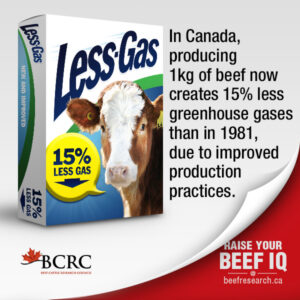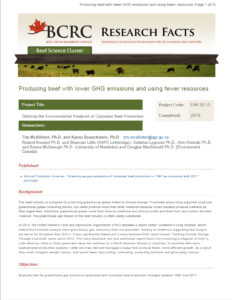The Environmental Hoofprint of Canada’s Beef Industry
Remarque : cette page web n’est actuellement disponible qu’en anglais.
Producing beef with lower GHG emissions and using fewer resources
Over the years, Canada’s beef industry has invested a lot of time and resources in, and reaped considerable economic benefits, from improvements in productivity and efficiency. With higher forage and feed crop yields, less land needs to be bought, leased or rented to produce the same number of calves or the same amount of beef. Similarly, improved feed conversions mean that less forage is needed to winter the cow herd or less feed grain is needed to grow a pound of beef.
These improvements in productivity and efficiency have also produced environmental benefits. To produce high yields, forages need an extensive root system that promotes healthy soil, healthy soil microbes, improves structure, reduces soil losses due to wind and water erosion, and builds up soil organic matter (also known as carbon sequestration). Better feed conversion efficiencies are accompanied by reductions in methane and manure production.
While the beef industry was pursuing business-focused improvements in productivity and efficiency, a lot of farm kids moved to town, and raised their families in urban settings that rarely (if ever) come in contact with agriculture. This knowledge gap about how beef is produced has provided opportunities for the beef industry’s opponents to undermine our environmental reputation. Our industry is particularly maligned for producing greenhouse gases linked to climate change.
Practically every living organism produces greenhouse gases, even plants, but cattle produce more than other livestock because rumen bacteria produce methane as they digest feed. Additional greenhouse gases come from manure (methane and nitrous oxide) and fossil fuel use (carbon dioxide). However, like the industry’s “water footprint” the greenhouse gas impact of the beef industry is often vastly overstated.
In 2006, the United Nation’s Food and Agriculture Organization (FAO) released a report called “Livestock’s Long Shadow” which stated that livestock produce more greenhouse gas emissions than transportation, leading to headlines suggesting that burgers are worse for the planet than SUV’s. It was significantly flawed because it counted all of the emissions involved in raising beef (e.g. emissions from cultivation and production of feed crops, grain drying, transport of feed, cattle and beef, etc.), but only the tailpipe emissions of vehicles (but not the emissions involved in extracting and refining the oil, steel, rubber, vehicle manufacturing, etc.). While beef producers took issue with that report for being unfair to our industry, anti-livestock activists also criticized that report for being too easy on meat.
A more balanced FAO report named “Tackling Climate Change Through Livestock” came out in 2013. This less publicized report found that producing a kilogram of beef in Latin America, India or China generates twice the methane as in North America, Europe or Australia. In countries with more sophisticated production systems, cattle are bred, fed and managed in ways that produce faster, more efficient growth. As a result they reach slaughter weight sooner, and spend fewer days eating, ruminating, producing methane and generating manure.
Dr. Getahun Legesse and collaborators at the University of Manitoba and AAFC Lethbridge are working on a Beef Science Cluster project that is measuring how the environmental footprint of the Canadian beef industry has changed between 1981 and 2011. The first paper from this project, entitled “Greenhouse Gas Emissions of Canadian Beef Production in 1981 as Compared to 2011” has been published in Animal Production Science.
What They Did
These researchers looked at many different Canadian research projects that studied how slight changes in reproductive rate, feed and forage crop yields, growth rates, carcass weights, etc. impact how much feed and land is needed to produce a kilogram of beef, and how much manure and greenhouse gases are produced as a consequence. A variety of data sources (e.g. Census of Agriculture data from Statistics Canada, Canadian Beef Grading Agency, Canfax, and large-scale producer surveys) were also used. Dairy steers that entered feedlots and cull dairy cows were considered to produce beef, but veal calves were not. A range of cow-herd winter feeding management practices (confinement, in-field feeding, swath-, bale- and stockpiled grazing) and feedlot production scenarios (calf-fed, backgrounded, and backgrounded-grassed before finishing) were considered. Regional differences in diets (corn-based feeding in the east vs. barley-based feeding in the west) were accounted for.
They combined the research information with the production data, and used a computer model to estimate how resource requirements (land base and breeding herd size) and greenhouse gas production changed over the 30-year period.
What They Learned
Canada produced 32% more beef in 2011 than in 1981. Much of this was due to higher carcass weights; in 2011, slaughter steers were 29% heavier and heifers were 45% heavier than they were in 1981. Producing the same amount of beef in 2011 required 29% less breeding stock, 27% fewer slaughter cattle and 24% less land, and produced 15% less greenhouse than in 1981.
Although some greenhouse gas emissions were from manure methane, CO2 (e.g. fuel use) and nitrous oxide from manure and soil, nearly three quarters of greenhouse gas emissions were due to enteric methane produced during digestion. Over 78% of the methane emissions occurred in the cow-calf sector, because the breeding herd spends nearly its whole life consuming forage-based diets that produce a lot more methane than grain-based diets do.
What It Means
Reductions in the beef industry’s environmental hoofprint have largely come through technologies that improve production efficiencies. On the cow-calf side, optimizing nutrition improves growth and reproductive performance. When more females get pregnant and successfully wean a calf, fewer heifers need to be retained as replacements, so the breeding herd is smaller. On the feedlot side, heifer carcass weight has increased due to growth promotants that overcame the biological disadvantages that heifers have relative to steers. Improvements in feed crop yields mean that a smaller land area is needed to produce the same amount of feed. In other words, many of the same things that improve productivity on the farm, ranch or feedlot also contribute to a smaller environmental hoofprint for the beef industry.
In the next few years this research team will use similar analyses to estimate how the Canadian beef industry and the pastures and rangelands it maintains impact water, carbon sequestration and biodiversity. This research study is focused on the historical changes in the beef industry’s environmental hoofprint between 1981 and 2011. It is designed to align with the National Beef Sustainability Assessment that the Canadian Roundtable for Sustainable Beef (CRSB) is conducting. The CRSB initiative is thoroughly evaluating the environmental, social and economic impacts of Canada’s beef industry from farm to fork based on 2013 practices and data. The intent is to repeat this assessment on an ongoing basis, sort of like the Beef Quality Audits, so that the industry can track our progress over time and identify opportunities for further improvements. Learn more about the CRSB.
- Related: The Canadian beef industry’s water footprint is shrinking – BCRC Blog, December 14, 2017
Click here to subscribe to the BCRC Blog and receive email notifications when new content is posted.
The sharing or reprinting of BCRC Blog articles is welcome and encouraged. Please provide acknowledgement to the Beef Cattle Research Council, list the website address, www.BeefResearch.ca, and let us know you chose to share the article by emailing us at info@beefresearch.ca.
We welcome your questions, comments and suggestions. Contact us directly or generate public discussion by posting your thoughts below.

